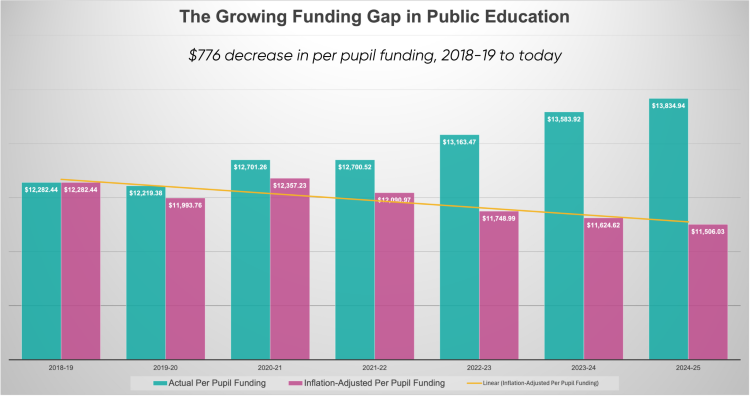While OPSBA welcomes the recent new investments announced by the government, including new capital funding and student mental health supports for vaping and smartphone addictions, and increased student transportation funding, last week's announcement falls short of what is needed to ensure all students are set up to succeed.
OPSBA's analysis shows that actual per-pupil funding is increasing a small amount from $13,584 to $13,834; an increase of $250, or 1.8% year over year. This will not cover the increased inflationary costs in a wide variety of budget lines, let alone the rising needs of our students following the COVID-19 pandemic. In 2018, at the start of the current government's time in office, per pupil funding was at $12,282.44. Since the height of the pandemic, per pupil funding has been trending down every year, further widening the growing gap in funding for public education. Funding, when adjusted for inflation, now sits at $11,506.03, a gap of $776.41 per student. This is the lowest level of per pupil funding in more than 10 years. With 1.3 million students in our English public system, this is a significant gap of more than a billion dollars. For a year-over-year analysis of education funding, please see the figure below.

"Just like for families and businesses, all costs in school board budgets are going up due to inflation. As we have not seen a corresponding increase in funding, there will be an impact on students," said OPSBA President Cathy Abraham. "School boards have budgets in which they allocate funds to buy goods and services. When the cost of these goods and services increases due to inflation, there is a direct impact on school board budgets."
It's not just school boards noting these inflationary pressures - staff federations, People for Education, and the Canadian Centre for Policy Alternatives have all noted that the past few years of funding increases do not cover costs, leading to cuts at the school board level.
Our comprehensive submission to the government in November outlined our member boards' priorities.
In particular, school boards note a significant issue regarding funding for statutory benefits - the Canada Pension Plan (CPP) and Employment Insurance (EI). Like all employers, school boards are required to pay these important statutory benefits. CPP has been gradually increasing from 4.95% in 2019 to 5.95% in 2023. This increase, mandated by the federal government, costs school boards money every year. The provincial government has not provided funding to cover this. In 2024, a second additional contribution rate was added. Similarly, EI has also been increasing over this time. This has led to an annual funding gap in just this one area of more than $100 million across English public school boards.
Despite the ongoing gap in funding, we will continue our advocacy for appropriate funding for public education. Nanos/OPSBA data from late 2022 shows that nine in ten Ontarians agree that spending on public education is an investment in the future. We know from a 2019 Conference Board of Canada report that "each dollar of public education spending generates $1.30 in total economic benefits to Ontario. At the same time, the inverse holds true for each dollar taken from public education."
OPSBA will continue to review the 2024-25 education funding grants and allocations, as well as the associated memoranda, to assess the impacts on school boards and students across Ontario. We look forward to ongoing discussions with the government to ensure that our schools have the necessary resources and supports that our students need to succeed.













